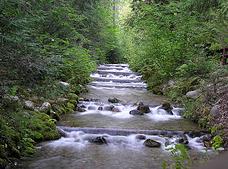 [5]Oregon Dept. of Fish and Wildlife [6],
[5]Oregon Dept. of Fish and Wildlife [6],
CLACKAMAS, Ore. – Fishery managers for the Oregon Department of Fish and Wildlife were expecting banner returns this year, but the number of coho passing over Willamette Falls is exceeding even the most optimistic forecasts. For the past week, ODFW’s fish monitoring station at Willamette Falls has been logging some of the largest returns since the facility began keeping records in 1946.
As of Sept. 13, 2,979 adult coho had crossed the falls on their way to spawning grounds in the upper Willamette and its tributaries.
“We have more fish over the falls already than we typically see for the whole year,” said Chris Kern, assistant fisheries manager for ODFW’s Ocean Salmon and Columbia River Program.
Fishery managers believe that if the current trend continues, the number of coho crossing into the upper Willamette could exceed the previous high of 17,900 adults counted in 1970.
What is more remarkable than the sheer number of fish is the type of coho that are returning to the upper Willamette. Almost all the fish counted at Willamette Falls were produced by natural spawning in the wild. The last time ODFW released hatchery-reared coho in the upper Willamette basin was in 1998, and the high returns in the early 1970s were generated from massive releases of hatchery coho fry and presmolts nearing 10 million annually.
“We’re not sure why, but for some reason they’re doing really well up there,” said Kern. “It looks like habitat restoration and other efforts are paying off.” Coho are also known to be very adaptive and able to utilize habitat not used by other fish.
The large coho returns expected throughout the Columbia River and its tributaries prompted ODFW to raise the bag limit on coho to three fish per day in many areas, including the upper Willamette and its tributaries. Above Willamette Falls, anglers are allowed to keep three coho, regardless of whether they are fin-clipped or unclipped fish.
Biologists expect the coho return in the upper Willamette will continue through mid- to late-October. Early on, angling for these coho will be best in the mainstem Willamette, particularly around the mouths of the larger tributaries like the Tualatin, Molalla and Yamhill rivers. Once fall advances, and cool rain elevates tributary flows, the coho will move into tributary streams, where they will be more accessible to bank anglers. ODFW advises that anglers read the 2009 Oregon Sport Fishing Regulations for information on gear restrictions and areas to fish.
“By the end of October it should be tailing off,” said Kern. “In the meantime, there should be lots of good opportunities for people to get out and catch these fish.”